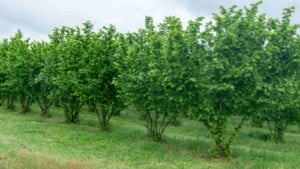Fresh sliced, canned or made into sauces, what could be better than a homegrown, organic tomato? The rich, sun-kissed taste of these juicy fruits makes growing tomatoes (Solanum lycopersicum) the Holy Grail of backyard gardeners everywhere! Start a number of varieties indoors up to two months before last frost. Once in the garden give them plenty of compost and keep them watered. Some cherry varieties, like candy on the vine, are ready in two months or more after transplanting; bigger varieties can take up to three months before harvest.
Tomatoes are not just good, they’re also good for you. Fruits are a rich source of antioxidants and contain many amazing health benefits. They offer super-sized amounts of vitamins A, C and K, as well as a host of other vitamins and minerals, including folic acid, potassium, iron and calcium. In other words, keep eating (and growing) them.
A word of caution: Conventionally grown tomatoes are in the top ten fruits and vegetables for containing pesticide residues. They’re also less nutritious than organic varieties. Now do you feel motivated to get those organic tomatoes started?
Fun fact: During Colonial Times, it was thought that if you ate a tomato, its poison would turn your blood into acid. Instead, the colonists grew them purely for decoration.

FREE SHIPPING!
Tomato Seeds
When’s the last time you had a fresh, great tasting tomato from the supermarket?
View allSo much sweeter, juicier and extra flavorful than a commercially-raised tomato, homegrown heirloom tomato seeds restore one of summer’s greatest pleasures. Planting instructions are included with each packet and shipping is FREE!
Quick Guide: Planting, Growing & Harvesting Tomatoes
- The hardest part of tomato gardening is choosing a variety, like cherry, beefsteak, heirloom, Roma, etc.
- Prepare soil be adding plenty of organic matter, but don’t overload with nitrogen
- For best production, start seeds indoors 5-6 weeks before the last frost.
- Plant seedlings deeply into well-prepared soil in full sun; water deeply a couple of times a week
- Harvest when fruits pull off the vine easily — green fruits can ripen indoors if frost hits
- See below for the list of pests and diseases
Site Preparation
Tomato plants are very deep rooted and don’t need nearly as much water as most people believe. They will do much better in garden soil than in pots and require plenty of sun.
Plant after the soil has warmed in the spring in rich, fast-draining soil which has been amended with ample amounts of garden compost, well-rotted animal manure and organic calcium to prevent blossom end rot.
Tip: Tomatoes are one of the few crops that can be grown in the same location for years. Studies have shown that they prefer to grow in compost made of their own foliage.
How to Plant
Most home gardeners buy seedlings or start their own seeds indoors about 5-8 weeks before the last frost date. Tomato plants love warm days and nights, so make sure you don’t plant out too early.
Allow enough space (1-1/2 – 3 feet) between plants to permit good sun penetration and air circulation. Plant tomatoes deep in the soil, up to the first set of leaves or deeper. Roots will form all along the stem. Water deeply for long periods of time once or twice a week to encourage roots to reach down into the soil. Once the plants are established, start them on a biweekly fertilizer program.
Tip: In northern climates use Wall O’ Waters to protect transplants from frost and speed production.
Support
Tomatoes need support to keep the fruit off the ground. Cages will work without additional ties as they start. But be warned — they will often outgrow their cages in just a few weeks! At that time, use bamboo poles or tree stakes and tie the plants with twine or covered wire (see Plant Supports & Twine). Place the twine around a main stem and pull it gently toward the stake. Secure the twine to the stake.
Pruning off young suckers between the main stem and leaf axils encourages higher yields and earlier fruiting on staked plants. When the vines reach the tops of the stakes, pinch back the tip.
No Bloom – What Happened?
Tomato plants that receive fertilizer too high in nitrogen will do a couple of things, none of which are good. They may not bloom at all, or they may drop the blossoms before the fruit has set. In order to prevent this from happening, use an organic fertilizer low in nitrogen or one specifically formulated for them.
Once plants start blooming, you may need to hand pollinate, especially if your crop is inside a greenhouse where there are no natural pollinators. To hand pollinate, you will need a small brush to pick up pollen from one flower and gently transfer it to another. Just tip your brush from flower to flower and pretend you are a bee.

Harvesting and Storage
Once tomato plants start ripening, check vines daily. Cut or gently twist off fruits, supporting the vine at the same time. For best flavor, leave the fruits on the plants for as long as possible. At first sign of heavy frost, harvest all fruits. Green ones will eventually ripen while stored in a warm place out of direct sunlight. Tomatoes require 90-140 days to mature from seed; 60-90 days from transplanting, depending on the variety.
Contrary to our common practice, storing tomatoes in a refrigerator is not recommended, as the cooler temperatures can cause them to lose flavor and get mushy.
Insect & Disease Problems
There are numerous insect and disease problems associated with tomatoes (too many to mention here). We have listed two of the more common problems:
Tomato Hornworm
Hornworms are impressive caterpillars that are very easy to control. They are identified by their impressive size (3-6 inches) and the spiked horn at the tail, but their green color makes them difficult to spot among the foliage.
To find tomato hornworms, simply follow the trail of chewed foliage. Then, look for their scat on the leaves. To control them, use diatomaceous earth as a dusting powder, hand pick them, or use bacillus thuringiensis as a spray for control. Although these are all organic remedies, please use safety gear when applying any pesticide.
Blossom End Rot
Blossom end rot is a tomato disease usually caused by a calcium deficiency in the soil, although it is sometimes brought on by drought, high salt levels, excess nitrogen or uneven soil moisture. It is identified by a brown mushy spot on the butt end of the fruit. Prevent blossom end rot by keeping soil evenly moist and by spraying plants with kelp extract or liquid calcium as a foliar treatment.
Note: Containing 14% phosphate and up to 24% calcium, organic bone meal promotes healthy fruit development.
Seed Saving Instructions
Cross-pollination between modern tomato varieties seldom occurs, except in potato leaf varieties which should be separated by the length of the garden. Do not save seeds from double fruits or from the first fruits of large varieties.
Pick at least one ripe fruit from each of several plants. Squeeze seeds and juice into a strainer and wash, spread on a paper plate and dry.











